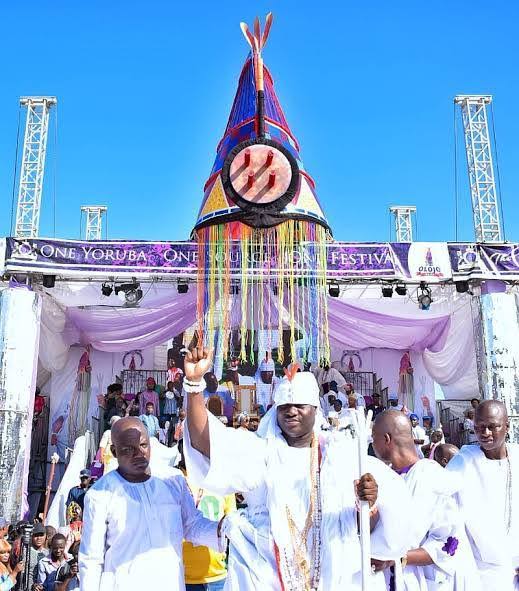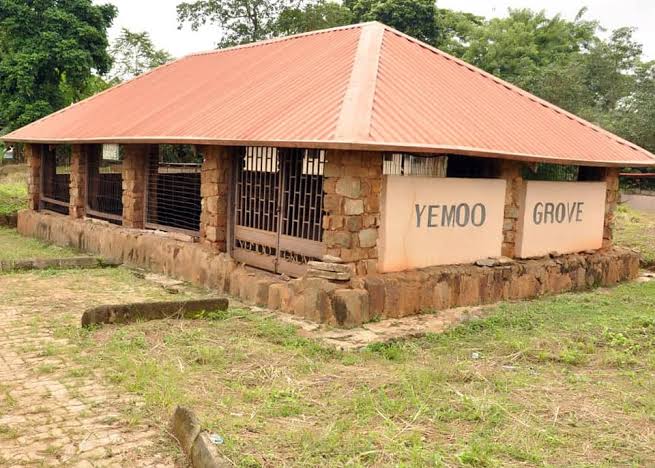HISTORICALLY BACKGROUND
“Olojo” in Yoruba literally means “the day of the first dawn.” The festival originates in Ile-Ife, the mythic cradle of the Yoruba and is held in remembrance of the primordial moment of creation and the role of Oduduwa (the progenitor of the Yoruba) and his offspring, notably Ògún (the god of iron). Across oral tradition and modern descriptions, Olojo commemorates creation, renewal and the spiritual authority of Ile-Ife as the ancestral, cosmological seat of the Yoruba race. The festival is ancient (centuries old) and remains one of the best-known ceremonial observances in Yorubaland.
SIGNIFICANCE
The festival operates at several levels:
Religious / cosmological: Olojo marks the “first dawn” of creation. Rituals invoke Olódùmarè (the Supreme Creator), Oduduwa and Ògún, seeking renewal, protection and fertility.
Political / social: It reinforces the Ooni’s spiritual leadership; the Ooni of Ife undertakes seclusion and rites before appearing publicly; the event renews the king’s covenant with the people and ancestors.
Cultural / identity: The festival is a powerful marker of Yoruba identity and unity; modern Ooni statements have framed Olojo as a celebration for the entire Black race, broadening its symbolic reach.
TIME OF CELEBRATION
Traditionally, Olojo is an annual festival usually held between September and October, though dates can be shifted and special circumstances have moved observance in particular years (reports show occasional changes). The week of activities typically culminates in a grand public ceremony when the Ooni appears with the ARE crown. Recent schedules show formal programmes announced yearly (e.g., a scheduled slate of events in late September).
RITUAL INVOLVEMENT, WHO DOES WHAT, THE OLOJO SEQUENCE IS HIGHLY RITUALISED. (Key elements):
Ooni of Ife (the monarch)—The Ooni goes into a period of seclusion (often seven days) before the main day with fasting, prayers and rites to commune with ancestors and purge spiritual impurities. Only after this seclusion does he reappear, wearing sacred regalia including the ancient ARE crown, to lead processions and perform shrine rites.
Araba and chief priests—Senior priests (including the Araba, a principal Ifa/priestly figure) perform divinations, renew oaths, and offer prayers and libations at ancestral and deity shrines (especially those associated with Ogun and Oduduwa).
Traditional chiefs and title-holders—Chiefs in full regalia (some carrying ceremonial swords) take part in processions and dances. Each chief often has a distinct dance style or chant associated with their title.
Women of the palace families—Certain cleansing/sweeping rites are performed by women from the Ooni’s maternal and paternal houses; these acts symbolically rid the palace of evil prior to the Ooni’s public emergence.
Masquerades, drummers and community: Drummers (bembe, osirigi and others), masquerades and ordinary citizens also participate in processions, prayers and communal celebrations. Only the Ooni may dance to some sacred drums (for example, the osirigi).
THE MAIN CEREMONIAL FLOW(concise)
1. Pre-festival seclusion and purification (Ooni and palace).
2. Private rites and prayers with priests (Ifa, Araba) at shrines, divination and sacrifices.
3. Public emergence of the Ooni in the Are crown, leading procession to important shrines and historic sites.
4. Community festivities; music, dance, cultural displays and hospitality.
HOW OLOJO RELATES TO YORUBA PEOPLE
Ile-Ife is regarded in Yoruba cosmology as the point where creation coalesced and human polity began. Olojo therefore functions as: An annual re-anchoring of Yoruba origin narratives (Oduduwa, Ògún, Ifa lore).
A cultural school— through songs, dress, speech, procession and ritual the younger generation learns lineage, protocol, and cosmology.
A pan-Yoruba rallying point — chiefs and visitors across Yorubaland often attend, linking Ife to other Yoruba centres politically and culturally.
PERSONALITIES AND OFFICES INVOLVED
Ooni of Ife, the central figure; modern Oonis (e.g., Oba Adeyeye Enitan Ogunwusi, Ojaja II) have promoted Olojo internationally.
Araba (senior Ifa priest) performs major priestly rites and divination.
Palace chiefs and elders, holders of traditional titles who carry swords, staffs and other insignia.
Masquerade captains, drummers, cultural officers and community organisers, they manage performances and public logistics.
THE “MAKE AND MAR” — factors that make the festival successful and factors that can mar it
MAKE(what ensures success):
Adherence to ritual protocol (proper seclusion, divination and shrine rites) — protects the sacred integrity of Olojo.
Community participation and transmission — active involvement of families, chiefs and youth keeps the festival alive.
Institutional support and planning — palace coordination, local government and tourism boards that handle security, traffic, sanitation and publicity.
MAR(risks and threats):
Commercialisation without ritual care — over-commercialising can dilute sacred meanings.
Poor logistics or security — crowd control, road access and sanitation problems can degrade visitor experience.
Health and pandemic risks — mass gatherings require public-health planning. (Historical examples worldwide show how festivals were altered for health reasons.)
Political and social tensions — any local dispute can affect attendance and tone.
PROSPECT IN RELATIONSHIP TO TOURISM
Olojo has strong tourism potential because it combines spectacle, history and living ritual. Opportunities include:
Cultural tourism packages (guided visits to historical Ife sites, shrine tours, craft markets).
Event tourism: the festival week can be marketed with cultural nights, craft exhibitions, culinary showcases, and heritage walks.
Diaspora engagement: the Ooni and palace have framed Olojo as an event for the Black diaspora, which can attract international visitors, cultural scholars and artists.
What’s needed for sustainable tourism: improved visitor infrastructure (hotels, signage, transport), trained guides conversant in ritual sensitivities, clear schedules, safety planning, and campaigns that respect, rather than commodify sacred aspects.
OTHER IMPORTANT EVENTS AND FESTIVALS ALIGNED WITH OLOJO /IN ILE IFE.
While Olojo is among the most famous, Ile-Ife also observes several other important cultural and religious events (some of which occur at different times of the year). Examples include Ifa festivals and other ancestral rites; these festivals interlock with Olojo in the palace ritual calendar and reinforce the same networks of priests, chiefs and devotees. (Ifa festival rites and palace calendars are distinct but complementary to Olojo.)
PRATICAL NOTES AND RECOMMENDATIONS (for planners, tourists, cultural officers)
For visitors–plan well in advance (dates are announced yearly), respect palace and shrine protocols (dress modestly where required), and use local guides.
For cultural managers–balance publicity with ritual integrity — create visitor briefings that explain what is sacred and where photography or access is restricted.
For tourism authorities–coordinate with palace elders and traditional priests so that commercialization funds support heritage preservation and community beliefs.






